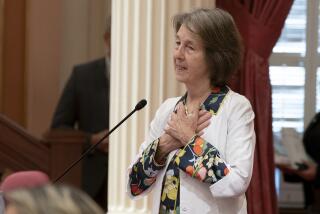AWOL from the classroom
It might be an exaggeration to say that California has a truancy crisis, but state Atty. Gen. Kamala Harris nonetheless made an important point last week about how schools mismanage troubling levels of absenteeism.
Officials estimate that there are close to 1 million elementary school students in the state who are truant each year, but that makes the problem sound worse than it is because any student who gets to campus late three times in an academic year is deemed to be truant. A more meaningful measure of the problem is chronic absenteeism — these are the students who miss 10% or more school days, or at least 18 days each academic year. But most schools in the state don’t even track how many students are chronically absent. The number that Harris used — 250,000 elementary students — is extrapolated from a small sample.
Still, the schools that do keep tabs have uncovered some dismaying numbers: Between 7% and 15% of students, and in a few cases even more, seem to be chronically absent. There are strong correlations between repeated absences as early as kindergarten and problems later on — low test scores, misbehavior and, ultimately, dropping out.
State schools Supt. Tom Torlakson followed up on Harris’ report by saying that he would push to tie school funding to attendance rates as a way of pressuring districts to undertake reforms. But schools already lose about $30 per absent student per day, and that hasn’t been enough to prompt changes. More important, that system is fundamentally unfair. Schools in affluent areas don’t have to work at making students attend school regularly, while schools in impoverished areas struggle. Why should the latter be punished by having funding reduced?
As Harris pointed out, some schools have pioneered an approach that puts at least a dent in habitual truancy: They appoint attendance boards to address repeated absences, even in the lowest grades. As soon as a student hits the 10% truancy mark — often by missing three of the first 30 days of school — the board contacts the family to see if it can determine the problem and bring in helpful services. That could mean, for example, connecting the family to better healthcare; asthma is one of the most common reasons for missing school.
Harris made truancy a hallmark of her tenure as San Francisco district attorney and a platform of her campaign for statewide office. Indeed, chronic absenteeism in San Francisco elementary schools fell from about 13% to 9% over a few years. More recently, the Los Angeles Unified School District shifted from a punitive policy in which police cited students for truancy if they were late, even if they were walking to school, to one designed to address the reasons for poor attendance. Within the last two years, chronic absenteeism has dropped from an average of 17% to a little less than 15%.
The rule statewide should be simple, and it should be enforced: If a student misses three days out of 30, it’s time to intervene. Now that Proposition 30 is providing additional funding for education, part of that money should go toward ensuring that students are in school. The best teachers and a new curriculum can’t help a student who isn’t there.
More to Read
Start your day right
Sign up for Essential California for news, features and recommendations from the L.A. Times and beyond in your inbox six days a week.
You may occasionally receive promotional content from the Los Angeles Times.






